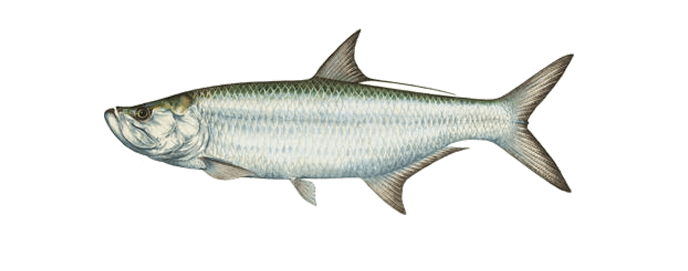Tarpon (Megalops atlanticus)
The Atlantic tarpon also is known as the Silver King due to their massive size and silver color. People from all around the world come to Florida to experience the thrill of catching a large tarpon. They are one of Florida’s premier game fish due to their strength, stamina, and a tendency make spectacular leaps out of the water when hooked. Some Tarpon can take up to three or four hours to land. They have very large flat scales and long slender bodies. They usually have a dark brownish green color on the back and the rest of the fish is a silvery white color. It has a large bony mouth with an elongated lower jaw that turns upward with small teeth that are like sandpaper. Tarpons have been around since prehistoric times. Tarpons can grow to be as large as eight feet long and weigh 355lbs. The largest Tarpon caught in Florida on conventional tackle was caught in key west and weighed 243 pounds. Tarpon is related to bonefish, ladyfish, and eels. William Halsey Wood is known as the father of big game fishing in Florida. He caught and documented a 93-pound Tarpon on March 19, 1885, using a five-foot bamboo rod with a mullet as bait. Thomas Edison was also a devoted tarpon angler. In Florida there are numerous fishing tournaments decided to Tarpon fishing from May until early August. If you want to catch Tarpon in Florida your going to need to have a bay boat, flats skiff, or access to a fishing pier/bridge. Tarpons grow very rapidly until there around seven years old with a length of about 30 inches when their growth rate slows dramatically. Adult Tarpons are known to live as long as 55 years. They are not good eating fish because they have too many bones but in countries like Panama and Africa they consider Tarpon as a delicacy.

How to catch Tarpon in Miami
Once you find a Tarpon or a school of Tarpon you should employ these tactics to land the big one. Setting the hook is one of the most difficult parts of catching a Tarpon. Tarpons have a tough mouth that is said to be as hard as concrete so using an inline five to seven size circle hook is crucial. Using a six-foot shock leader made of fluorocarbon or mono will also help you land more Tarpon. For your main line, you don’t want to go less than 20-pound braid but we recommend 60 to 80-pound braid to land those big Silver King’s. You want to throw your bait out in front of them beyond where they are traveling and slowly reel in. When the Tarpon jumps out fo the water a couple of times they tend to throw the hook so using a circle hook will make sure they don’t get away. A popular term among Tarpon fisherman is “how many tarpons did you jump?” instead of how many did you catch because they can be so hard to hook. You also want to make sure you have plenty of fishing line because these fish can pull strong. Once you feel a bit from a tarpon you should not try to set the hook but just reel in at a steady pace keeping tension on the line. If you’re using a lure the same rules apply. You need to get your bait way in front of the fish and then slowly reel in and repeat until you land a beast.

Where to fish for Tarpon
Tarpons populate a wide variety of habitats and prefer water temperatures between 72 degrees to 82 degrees Fahrenheit. If the temperature drops below 60 degrees they become inactive and don’t feed. If the temperature gets lower than 40 °F it can kill the tarpon which is why they love hanging out in warmer coastal Miami waters. You can also fish for Tarpon in and around piers and bridges as well as around Marinas. Fast moving water around bridges makes it an ideal spot to catch Tarpon. They can also be found in shallow coastal waters, estuaries, lagoons, and rivers. Taking a good pair of binoculars is a great tool to have on board for spotting rolling tarpon in the distance. When they are younger than two years old they like to hang out in brackish water around marsh channels, estuaries, salt marshes, creeks, and rivers. They can also be found offshore near wrecks and coral reefs. You can go on some of the most incredible Tarpon Fishing Charters in Key West. During sunset using live bait around Shark channel bridge in Key West is always a hot spot for Tarpon fishing in the Keys. Fishing the middle of Long Key Bridge officially known as the Dante B. Fascell Bridge in Key West during sunrise or sunset can always land you a large Tarpon.
Best time of the year for Miami Tarpon fishing
The best time to fish for Tarpon in Florida is during the migration from April until July. Fishing before the sun comes up and right before it goes down is also a good strategy. Fishing on a cloudy day with a little wind is also a great time to target these monster game fish. In March tarpon flood to the keys because of the mullet run and can be found all throughout Florida. If your fishing with lures you should use dark colors such as black for night time fishing and white or light colors for daytime Tarpon fishing. Fishing during the outgoing tide funnels bait fish threw bridges making it a great time to fish for Tarpon. In reality, Tarpon can be caught all year round when your fishing with a Tarpon fishing carter in Miami that has experience.
The best bait to catch Tarpon
Tarpons love shrimp but they also like to eat mullet, pinfish, Threadfin hearing, grunts, as well as blue crabs. If your using shrimp make sure you remove the head and attach it by the tail so that it doesn’t spin. They will also go after fishing lures, trolled spoons and jigs. The hoagie 10-inch swimbaits in Black or White are very effective Tarpon bait because they imitate mullet. If the Tarpons are going after schools of pilchards or sardines then switching over to a large paddle tail. Another great lure to use is a five or six inch Pink, Black or Orange gulp saltwater jerk shad is a great choice for Tarpon fishing in Miami. Regardless if your using live bait or lures they key is to make sure it’s not spinning and is swimming naturally. Setting up your bait properly is just as important as what bait you use. Two more great options for fishing lures that catch Tarpon are the MirrOdine XL Suspending Twitchbait and Spotted Trout Series TTR Sinking Twitchbait. chumming the water near Tarpon can cause them tome closer in search of bait fish.
Florida Tarpon fishing regulations
Once you have purchased a Florida saltwater fishing license you will also need to get a special Tarpon permit or tag that cost a little extra. In Florida On Sept. 1, 2013, the Florida Wildlife Commision made tarpon catch-and-release only. Without the tag, you are not allowed to possess a Tarpon. If you want to keep you will need to buy a $50 tag for each fish. The tags are sold exclusively at some tax collector’s offices without exemption. Anglers need to mail their return cards to the Florida Fish and Wildlife Conservation Commission’s Fish and Wildlife Research Institute by the end of August each year in order to avoid penalties. You must provide the Florida Marine Research Institute with information about the catch, including date and location of capture, the weight, and length of the fish, as well as how many anglers were fishing. If you want to take a selfie you should leave the fish in the water while photographing it. Putting the fish inside the boat can cause injury to both you and the fish. Try to reduce handle time by releasing them back as quick as possible. While handling the fish make sure to use wet hands or a wet towel and never touch the gills. If you do decide to bring the fish onboard you should hold on to the tail to the fish is revived and swims away. In Florida, it is illegal to sell Tarpon commercially. The permit has dropped the number of Tarpon killed from 342 in 1989 to 70 in 1998.












